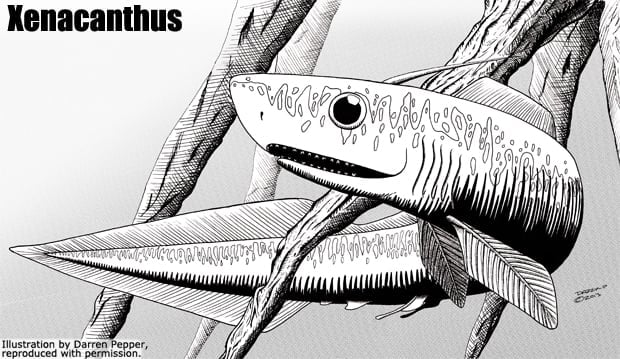In Depth
Name: Xenacanthus (Foreign spike).
Phonetic: Zee-nah-can-thus.
Named By: Heinrich Ernst Beyrich - 1848.
Synonyms: Pleuracanthus.
Classification: Chordata, Chondrichthyes, Elasmobranchii, Xenacanthida, Xenacanthidae.
Species: X. atriossis, X. compressus, X. decheni, X. denticulatus, X. erectus, X. gibbosus, X. gracilis, X. howsei, X. indicus, X. laevissimus, X. latus, X. luedernesis, X. moorei, X. ossiani, X. ovalis, X. parallelus, X. parvidens, X. robustus, X. serratus, X. slaughteri, X. taylori.
Type: Carnivore.
Size: Up to 1 meter long.
Known locations: USA, Europe and India.
Time period: Devonian through to the end of the Triassic.
Fossil representation: Mostly fossilised teeth and spines, some preserved body impressions are known. As an ancestral shark, Xenacanthus had a morphology more akin to an eel than any of the lamniform sharks we know today. Xenacanthus also lived in freshwater and probably hunted in river systems. Regardless of this freshwater existence, Xenacanthus has a very broad distribution and is present in the fossil record for a long time, and across many continents. Aside from the main body having an ‘eel like’ shape, the dorsal fin also ran down the length of Xenacanthus where it joined the caudal fin which then joined the anal fin underneath. This accentuated the eel morphology even more, although the fins on the underside of Xenacanthus were distinctly more shark like.
The spine that rises from the back of the head is one of the most striking features and is thought to have served as a deterrent against larger predators. The spike has even been speculated to have been poisonous, perhaps in a similar manner to a sting ray. This is quite plausible as the rays are close relatives to the sharks.
The enlarged spikes are also seen in other early sharks such as Hybodus. Even though Hybodus has a more ‘traditional’ shark morphology, it still has elongated spines rising up from in front of both of its dorsal fins.
Further Reading
– A new Xenacanthiformes shark (Chondrichthyes, Elasmobranchii) from the Late Paleozoic Rio do Rasto Formation (Paran� Basin), Southern Brazil. An. Acad. Bras. Ci�nc. – vol.86, n.1, pp.135-145. – Victor E. Pauliv, Eliseu V. Dias, Fernando A. Sedor & Ana Maria Ribeiro – 2014.











